Every year, on the 12 of October we in Bali remember the horrors of the Bali Bombing in 2002. How many react to the memory is sadly with the typical anger fostered by our cultural and political obsession – i.e. the contemporary fear of extremism – as well as a deep mourning for those lost.
Now, what we haven’t considered is the island’s view on the matter, after all, Bali and its people were the main victims of this tragedy. Is there perhaps an alternate view on the reasons behind the bombing? Of course there are, we are on the Island of The Gods.
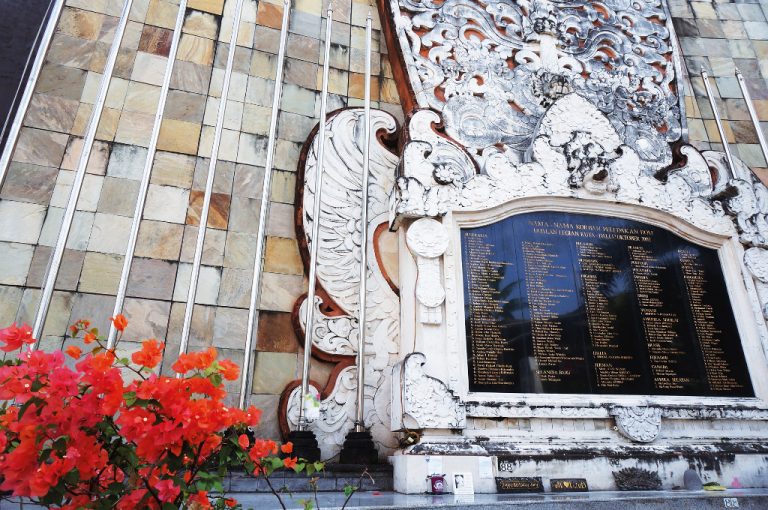
We have not even considered the possibility that the idea of commemorating the event may be an “alien” concept to the Balinese. For western cultures, historical disasters such as the world wars or 9/11 etc., are always remembered and respected. However, the Balinese have traditionally lived their lives around what is considered “cyclical time”, the time of rites, with the 210 Pawukon calendar intermingled with the Saka lunar-solar calendar of 354 days. Perhaps “historical time” is of little importance, and therefore such historical moments of the past are too.
What of national celebrations such as the Indonesian Independence Day on August 17th, or other national commemorations, such as Ibu Kartini Day? They are all examples of moments of the Gregorian calendar, which slowly solidifies ideas of State, the Nation and perhaps even of Western modernity as the capital moves towards it. In truth it is an intrusion into the culture and tradition of everyday Balinese life, if governed by traditional calendars and time-keeping.
The Franco-Indonesian museographer Adjie Damais, a man as well-informed and cultured as one can be, once told me an interesting insight regarding Javanese and Balinese kin cultures:-
“Apart from ‘myth’ events, we don’t have any real “memory”. Whether horrible or not, events in our year just come and go, as if not rooted in historical reality. For this reason the idea that we may have to avenge a crime or insult does not come to us. After the 1965 GESTOK killings –the slaughter of real and supposed communists— perpetrators and victims’ relatives continued coexisting with one another without thinking of exacting further revenge. As if crimes were erased by time, instead of being carved into it.”
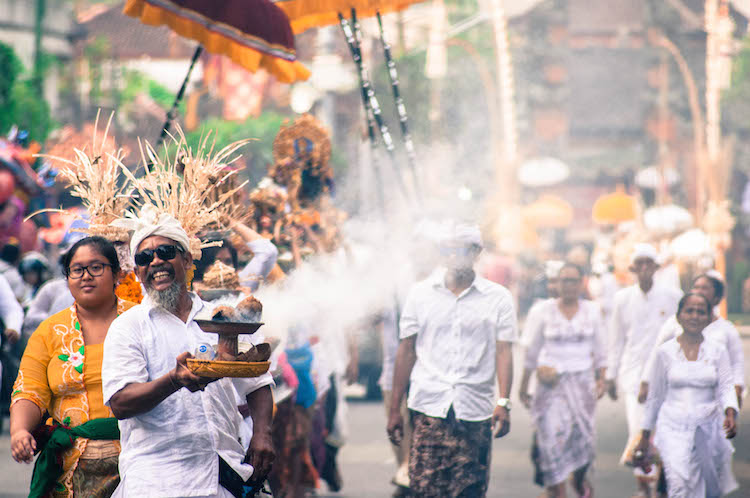
So what happened after the bombing? Were local people called up to retaliate? Were mosques put ablaze by wild mobs? Did we witness lynchings of muslim neighbours? No.. of course not! The bombing was perceived not as an attack by Islam, but as a sign of cosmic disorder. Hence, instead of calls for revenge which, if followed, would have further reinforced this disorder, there simply were, Bali being Bali, calls for ceremonies: the malevolent forces at work in the bombing were, and had to be, appeased by rites and offerings.
An Exorcism for the World
The giant exorcism is called Pemarisudha Kunarbaya, literally in ritual Kawi language “the great purification to cope with a major woe”. Each major woe or catastrophe reveals a loss of balance, be it at the level of the person, of the village, the island, or the Bhwana, the world itself. And each has its own corresponding exorcizing rites. The Pemarisudha Karipubaya ceremony was aimed at the Bhwana, a world in awe at the horror of the bombing. Conducted on November 13th, 14th and 15th November, this exorcising ceremony was of the biggest possible kind. Many Balinese considered it a success: the countless recitation of mantras appeased for them the tensions born from horror and the presence of death. Balinese cultural memory could henceforth focus not on hatred, but on the restored, albeit provisional, balance of the world. So it was not Islam that had struck. It was the Great Chaos, the Rogha Sanghara Bhumi, attributed to the Kali Yuga age. The Kali Yuga age is the last of 4 eras, described as the time where man and spirituality are at its farthest, to which will eventually result in the end of eras of eternal times and the Universe itself.
What the Balinese themselves have written regarding Kuta bombing largely differs from what foreign media has written. In the Bali Post (13/11/2002) it explained that the event was “a sign of prevailing cosmic order.. There are numerous signs of an approaching cataclysmic period (Rogha Sanghara Bhumi). The gods have abandoned the world to go back to their divine abode, and their place has been taken over by the demonic forces of the bhuta kala, which infiltrate all aspects of daily life…What is true is told to be false, and what is false told to be true…Disorder is overwhelming the world. People are insulting one another, killing one another and have wild behaviors never seen before”. The Kuta bomb is among those wild behaviours.
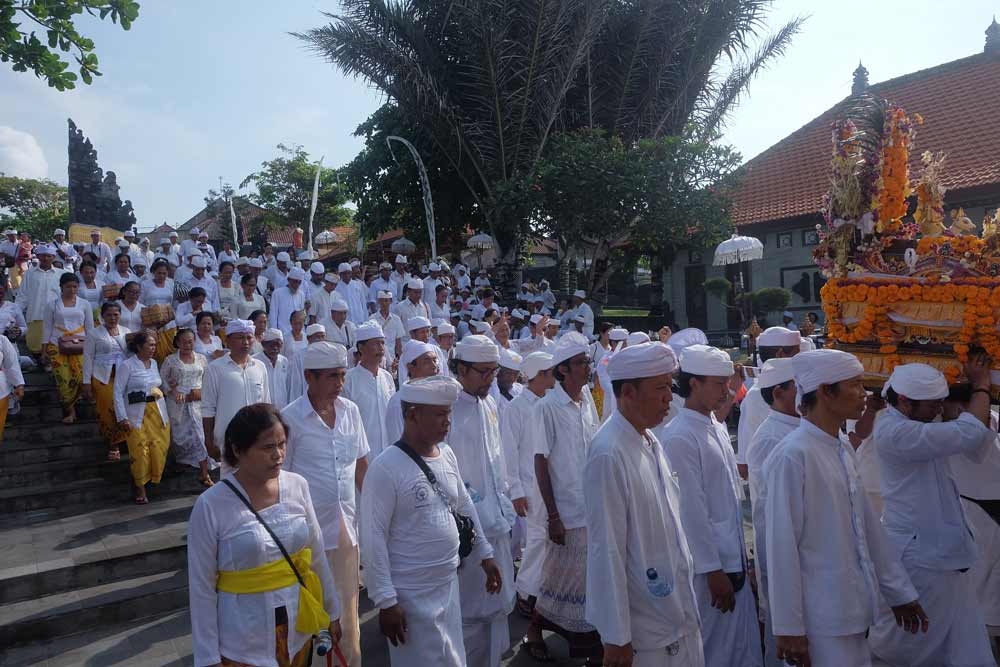
The Meeting of the Gods
An interpretation given by Wayan Sadha, written as a short story in Balinese called Paruman Batara, or ‘The Meeting of the Gods’, portrays this localised view, encapsulating the aforementioned Balinese-Hindu philosophical belief of the disaster.
First, depicting Kuta, he writes: “Defilement of Bali is at its highest in Kuta. There are to be found people of all ilk, whose behaviour is a shame to their quality of human beings: they don’t recognise the authority of God the Supreme, Ida Batara Sesuhunan, nor that of the residing gods of Pasar Agung Temple, Pura Tunon temple, Pura Bagus Truna temple, nor the temples in Legian and Kuta. Some of those people even behave like animals, and whatever remonstrance or protest one may address to them, they don’t give a damn. This is the reason why so many evildoers from foreign lands come and settle in Kuta. Some indulge in narcotics, others in alcoholic beverages, not to mention the women who make trade of their flesh… be matah. All share a common obsession with money.”
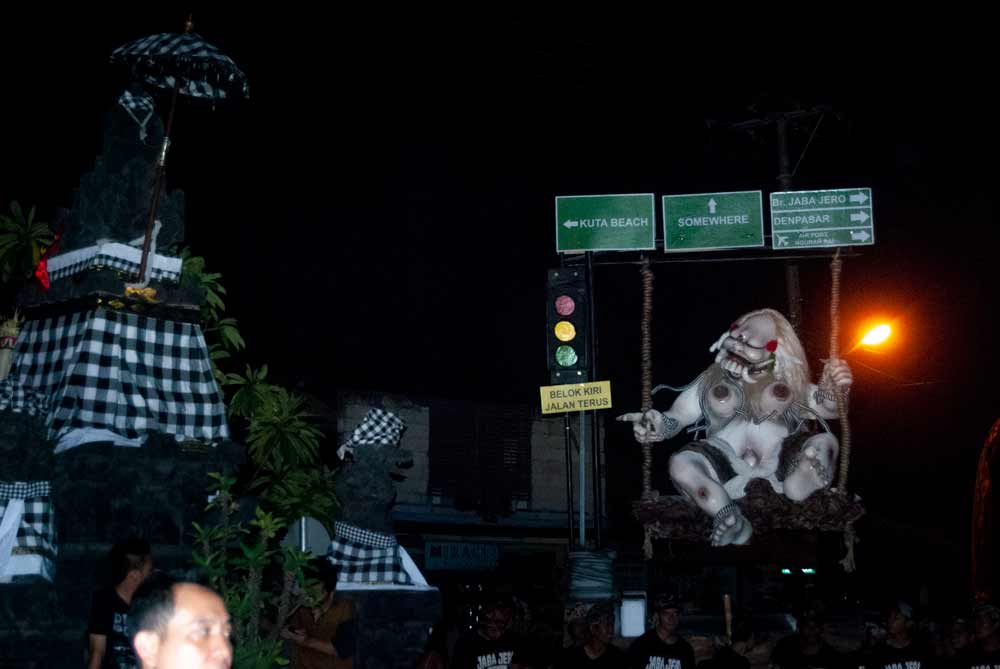
These are the signs of the above-mentioned cosmic disorder. In the middle of such disorder, Wayan Sadha introduces a witness, Nang Kocong. Nang Kocong first goes to the Paddy Club (one of the two bombed night-clubs) where he witnesses the “long-nosed ones” (Caucasians) “wriggling on the dance floor as if they had been bitten by thousands of poisonous ants”.
Upon leaving the Paddy Club, Nang Kocong, in a sort of narcotic stupor, enters the temple of the dead (Pura Dalem) where, hidden behind a wall, he witnesses a meeting of gods and demonic gods discussing which measures have to be taken to cope with a world that has now become “old”, or gumi wayah, and thus rotten.
“All the gods were present there, dozens of them,” writes Sadha. “There was Ida Batara Sesuhunan (the Supreme One), Batara Bagus Truna (the Young One), Batara Tunon (the Lord of the burning ground), Batara Kahyangan (the god of the godly abode), Batara Mrajapati (Lord of the cemetery), Batari Durga (Shiva’s consort), Batara Desa Puseh (the Lord of the temple of origin), Sanghyang Catuspata (the lord of the crossroads), without forgetting of course the guardian of Hindu hell Sanghyang Suratma and the lord of hell himself, Batara Yamadipati.”
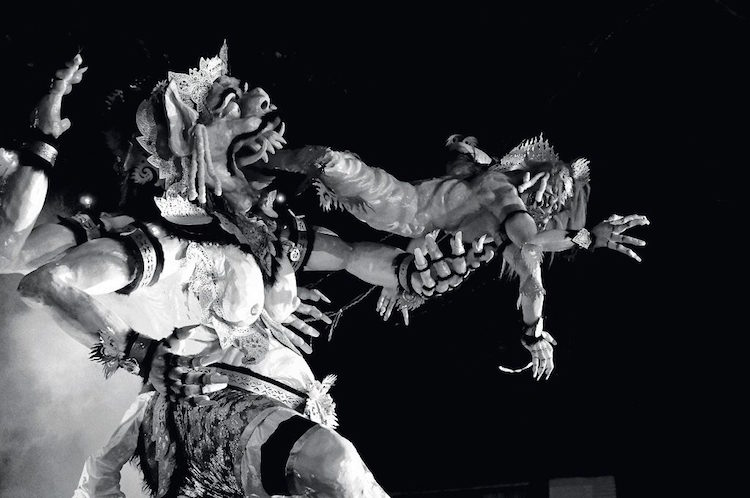
As the assemblage of gods discussed, a messenger suddenly appeared with a message from Jero Gede Mecaling, the Lord of Nusa, once the leader of the wong samar, the feared spirits. Mecaling told the gods that there should be a sacrifice made to him: “In old times,” said his messenger, “whenever the Balinese forgot their duties toward the gods, we would devastate the island with the plague and other scourges, but now, it is not so much the Balinese we are after to “send to the country of the void, sunya loka [to pass on]. They still perform their prayers to the gods and present them with offerings. It is the outlanders, many of whom already have their names registered on the list of the deceased: some are Javanese, others are Americans, Germans, Japanese and many are Australians. Many are followers of god Sang Hyang Yesus Kristus. There is only one problem we are faced with regarding these people. To send so many to the “realm of void” (death), we need a proper vehicle.”
“Nang Kocong didn’t lose a word of the exchange. As he was listening, one of the gods present, Sang Hyang Narada (the messenger god), came up triumphantly with a ready-made solution:“ I recently got news from the city of Banten in Java, it informed me of the recent creation of a company specialised on sending people to “the realm of the void”. This company, called Amrozy Imam Samudra and Co. (the actual terrorists), is ready to provide transportation for those already registered to the “realm of the void”… So, you should now be able to fulfill Batara Gede Mecaling’s request of sacrifice…”
What remained to be done was for the gods to take over the mind of the young Javanese men of Amrozy Imam Samudra and Co. This was done without any hurdle. The rest has become news: the bombing and those that were killed, and, following it, the stark awareness by the Balinese of the cosmic disorder, and the balance restored through rite.
This short story depicts for us a tolerant view, one that does not blame the outsider (the terrorist from Java), but rather turns the responsibility back on the Balinese with a moment of self-reflection. A questioning of identity and of morals. A lesson.
Yet, must we think that all the future political disorders that will occur in Bali shall continue being interpreted at the light of the notion of cosmic disorder? Probably not. The slow but steady disintegration of Balinese traditional society is undoubtedly under way, caused by migration, urbanisation, changes in land use and ownership. It will take more than rites and ceremonies to appease all future disorders on the island of the gods.
[If you like this article, perhaps you may like to read : Islam & Tolerance in Bali]






